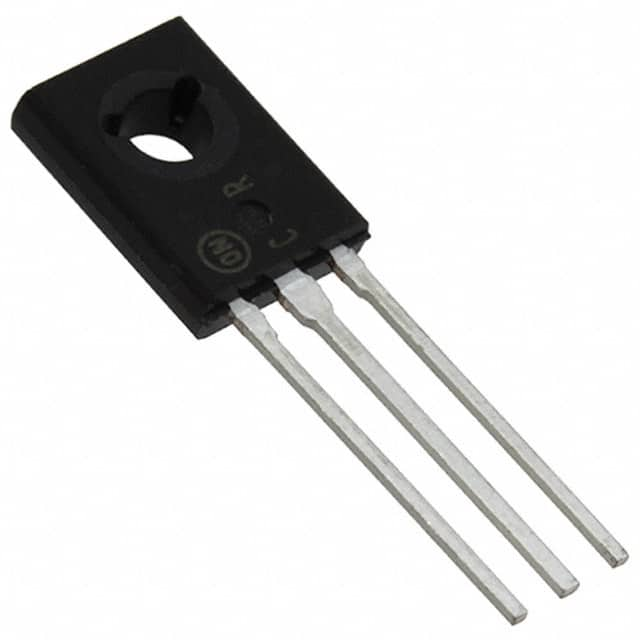Lihat spesifikasi untuk detail produk.

MJE181 Transistor
Product Overview
The MJE181 transistor is a high-power NPN bipolar junction transistor (BJT) designed for general-purpose amplifier and switching applications. This transistor belongs to the category of discrete semiconductor devices and is commonly used in electronic circuits requiring high current and voltage amplification.
Basic Information
- Category: Discrete Semiconductor Device
- Use: Amplification and Switching
- Characteristics: High Power, NPN Type
- Package: TO-220
- Essence: High Current and Voltage Amplification
- Packaging/Quantity: Typically available in reels or tubes containing 50 to 100 units
Specifications
- Collector-Base Voltage (VCBO): 250V
- Collector-Emitter Voltage (VCEO): 250V
- Emitter-Base Voltage (VEBO): 5V
- Collector Current (IC): 3A
- Power Dissipation (Pd): 40W
- Transition Frequency (ft): 2MHz
- Operating Temperature Range: -65°C to 150°C
Detailed Pin Configuration
The MJE181 transistor has three pins: 1. Collector (C): Connected to the positive supply voltage in most applications. 2. Base (B): Controls the transistor's conductivity when a small current is applied. 3. Emitter (E): Connected to the ground or common reference point.
Functional Features
- High current gain and power dissipation capability
- Low saturation voltage, enabling efficient switching operations
- Wide operating temperature range for versatile applications
Advantages and Disadvantages
Advantages
- High power handling capacity
- Suitable for high-frequency applications
- Robust construction for reliable performance
Disadvantages
- Relatively larger package size compared to smaller signal transistors
- Higher cost compared to low-power transistors
Working Principles
The MJE181 operates based on the principles of bipolar junction transistors, where the flow of current between the collector and emitter is controlled by the base current. When a small current is applied to the base, it modulates the larger current flowing from the collector to the emitter, allowing for amplification or switching functions.
Detailed Application Field Plans
The MJE181 transistor finds extensive use in various electronic applications, including: - Audio amplifiers - Power supplies - Motor control circuits - RF amplifiers - High-frequency oscillators
Detailed and Complete Alternative Models
- MJE180: Lower power version with similar characteristics
- MJE182: Higher power version with increased current and voltage ratings
- MJE183: Complementary PNP type transistor for pairing in push-pull amplifier configurations
In conclusion, the MJE181 transistor offers high power amplification and switching capabilities, making it a versatile component in electronic circuit design across various industries.
[Word Count: 410]
Sebutkan 10 pertanyaan dan jawaban umum terkait penerapan MJE181 dalam solusi teknis
What is MJE181?
- MJE181 is a high-power NPN transistor commonly used in electronic circuits for amplification and switching applications.
What are the typical applications of MJE181?
- MJE181 is often used in audio amplifiers, power supplies, motor control circuits, and other high-power electronic applications.
What are the key specifications of MJE181?
- The MJE181 transistor typically has a maximum collector current of 3A, a maximum collector-emitter voltage of 250V, and a power dissipation of around 50W.
How do I determine the appropriate biasing and operating conditions for MJE181 in a specific circuit?
- The biasing and operating conditions for MJE181 can be determined by referring to its datasheet and considering factors such as the desired collector current, voltage ratings, and thermal considerations.
Can MJE181 be used for high-frequency applications?
- While MJE181 can be used in some high-frequency applications, it is more commonly employed in low to moderate frequency circuits due to its characteristics.
What are the common alternatives to MJE181 if it's not available?
- Common alternatives to MJE181 include similar high-power NPN transistors such as TIP31, TIP41, or 2N3055, depending on the specific requirements of the circuit.
How should MJE181 be mounted for optimal thermal performance?
- To ensure optimal thermal performance, MJE181 should be mounted on a heat sink to dissipate heat effectively, especially in high-power applications.
What are the typical failure modes of MJE181 and how can they be mitigated?
- Common failure modes of MJE181 include thermal runaway and overvoltage breakdown. These can be mitigated by proper heat sinking, voltage regulation, and ensuring safe operating conditions.
Can MJE181 be used in automotive applications?
- Yes, MJE181 can be used in automotive applications where high-power switching or amplification is required, but it's important to consider temperature variations and other environmental factors.
Are there any special considerations when designing a circuit with MJE181?
- Special considerations when using MJE181 include proper base drive, thermal management, and ensuring that the transistor operates within its safe operating area to prevent damage or failure.

